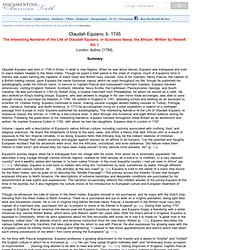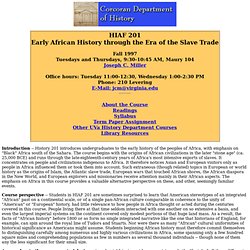

Summary of The Interesting Narrative of the Life of Olaudah Equiano, or Gustavus Vassa, the African. Written by Himself. Vol. I. Olaudah Equiano was born in 1745 in Eboe, in what is now Nigeria.

When he was about eleven, Equiano was kidnapped and sold to slave traders headed to the West Indies. Though he spent a brief period in the state of Virginia, much of Equiano's time in slavery was spent serving the captains of slave ships and British navy vessels. One of his masters, Henry Pascal, the captain of a British trading vessel, gave Equiano the name Gustavas Vassa, which he used throughout his life, though he published his autobiography under his African name. In service to Captain Pascal and subsequent merchant masters, Equiano traveled extensively, visiting England, Holland, Scotland, Gibraltar, Nova Scotia, the Caribbean, Pennsylvania, Georgia, and South Carolina.
He was purchased in 1763 by Robert King, a Quaker merchant from Philadelphia, for whom he served as a clerk. Equiano's journey begins when he is kidnapped from his village with his sister, from whom he is eventually separated. Jenn Williamson. HIAF 201. Introduction -- History 201 introduces undergraduates to the early history of the peoples of Africa, with emphasis on "Black" Africa south of the Sahara.

The course begins with the origins of African civilizations in the later "stone age" (ca. 25,000 BCE) and runs through the late-eighteenth-century years of Africa's most intensive exports of slaves. It concentrates on people and civilizations indigenous to Africa. It therefore notices Asian and European visitors only as people in Africa influenced them or took them into account. Such extraneous (though related) topics in European or world history as the origins of Islam, the Atlantic slave trade, European wars that touched African shores, the African diaspora in the New World, and European explorers and missionaries receive attention mainly in their African aspects.
The emphasis on Africa in this course provides a valuable alternative perspective on these, and other, seemingly familiar events. Teaching assistant. Slavery Images. The 1,280 images in this collection have been selected from a wide range of sources, most of them dating from the period of slavery.

This collection is envisioned as a tool and a resource that can be used by teachers, researchers, students, and the general public - in brief, anyone interested in the experiences of Africans who were enslaved and transported to the Americas and the lives of their descendants in the slave societies of the New World. We would like to emphasize that little effort is made to interpret the images and establish the historical authenticity or accuracy of what they display. To accomplish this would constitute a major and different research effort. Individual users of this collection must decide such issues for themselves. Copyright 2015, Virginia Foundation for the Humanities and University of Virginia. University of Massachusetts Amherst - Department of History. Reading/Discussion Questions for Equiano’s Narrative. Trans-Atlantic Slave Trade.
Roll over names of designated regions on the map above for descriptions of the role of each in the trans-Atlantic slave trade.

The North American mainland played a relatively minor role in the trans-Atlantic slave trade. Its ports sent out less than five percent of all known voyages, and its slave markets absorbed less than four percent of all slaves carried off from Africa. An intra-American trade in slaves – originating in the Caribbean - supplied additional slaves, however. This region was exceptional in the Americas in that a positive rate of natural population growth began relatively early, thus reducing the dependence of the region on coerced migrants. The Caribbean was one of the two major broad regional markets for slaves from Africa.
Brazil was the center of the slave trade carried on under the Portuguese flag, both before and after Brazilian independence in 1822, and Portugal was by far the largest of the national carriers.